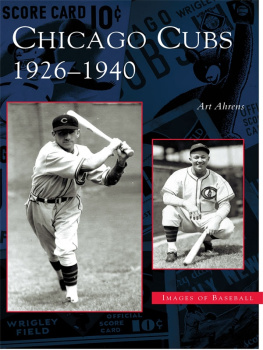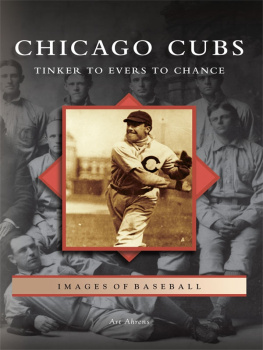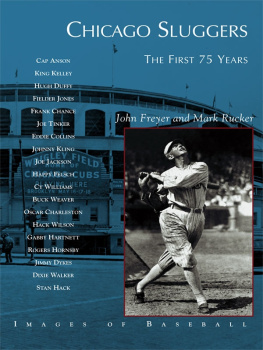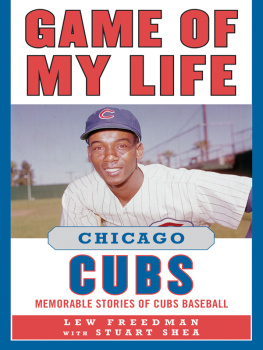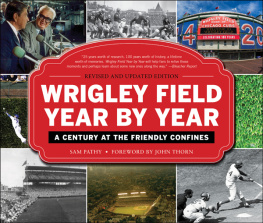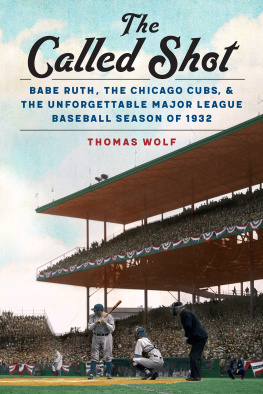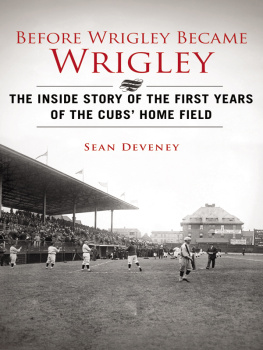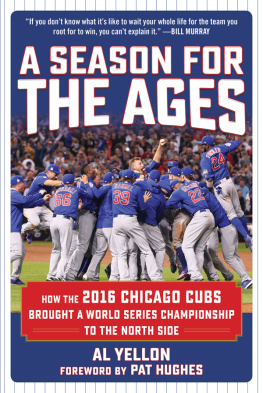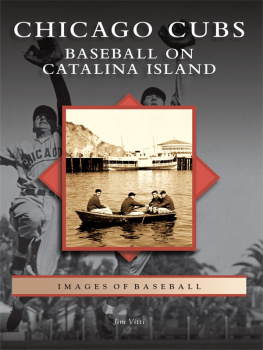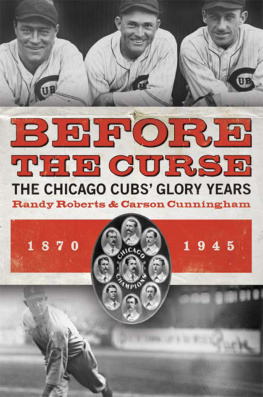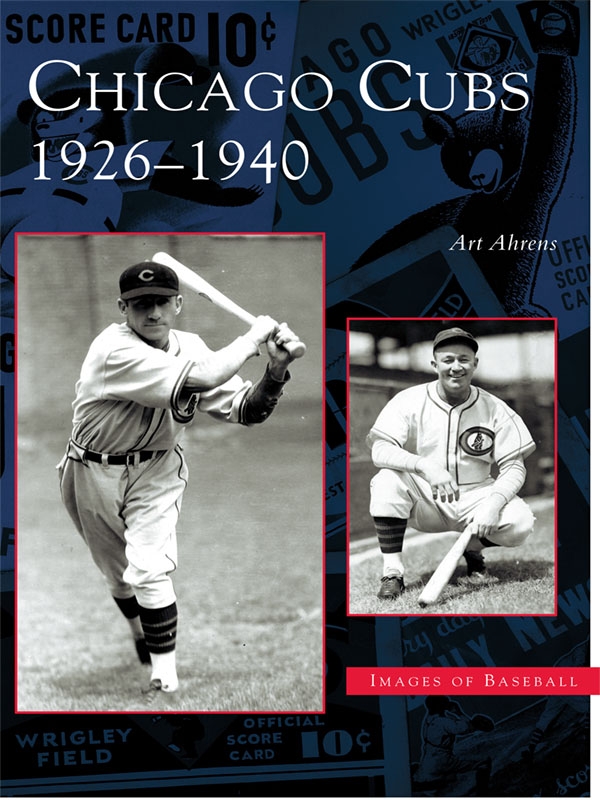Epilogue
Decline and War Years
During the winter of 19401941, Phillip K. Wrigley hired Jimmy Wilson, a retired catcher, to replace Gabby Hartnett as field boss and sportswriter James Gallagher as the Cubs first general manager. Together, the James Boys embarked on a series of trades that made the Cubs look like a farm team for the Dodgers.
Jealous of Billy Hermans overwhelming popularity, Wilson talked Gallagher into swapping the great second baseman to Brooklyn for outfielder Charlie Gilbert, infielder Johnny Hudson, and $40,000 cash early in the 1941 season. Lou Stringer, Hermans replacement at the Keystone sack, could not hold a candle to Billy Herman. Later in the season, Augie Galan and Larry French were also dealt to the Lords of Flatbush. Thought to be washed up, they both discovered the fountain of youth in their new uniforms.
The result? The Dodgers won their first pennant in 21 years and the Cubs sank to sixth place as weaknesses, which were visible the previous season, grew increasingly glaring. Pitching and defense were on the decline, and hitting was inconsistent. While the Dodgers and Cardinals had built massive farm systems, the Cubs lagged behind in that area as the younger Wrigleys incompetence as an owner was becoming evident. Their most touted rookie, outfielder Lou Novikoff, batted .241 in 70 games before being sent back to Los Angeles for more seasoning.
At the tail-end of the season, the Cubs front office announced that the team would be having some night games beginning in 1942. However, following the Japanese attack on Pearl Harbor, Wrigley donated the light poles to the government as scrap metal for the war effort. By the time World War II was over, Wrigley had changed his mind concerning night baseball and the park would remain without lights until 1988.
Pearl Harbor affected more than night baseball at Wrigley Field, as the big leagues heard the call from Uncle Sam. While the 1942 season was almost up to pre-war standards, the quality of baseball dropped like a falling star thereafter. With most of the real talent being gobbled up by the military, major league rosters brimmed with fuzzy-faced teenagers, Triple-A lifers, and aging has-beens who were too old to be drafted.
For the Cubs, it was a time when such legendary (if not overly successful) characters as Lennie Merullo, Dom Dallessandro, Hiram Bithorn, Paul Erickson, Heinz Becker, and the aforementioned Lou Novikoff flourished. While the period was more memorable for laughs than victories, the story about the fly ball bouncing off Novikoffs head is purely apocryphal.
Weak up the middle and with few quality pitchers, the Cubs repeated their sixth-place finish in 1942. Fans could look with pride only to the steady play of Stan Hack and husky catcher Clyde McCullough; the slugging of Bill Nicholson; the pitching of Claude Passeau; and the hustling of Phil Cavarretta, who had been recycled at first base after several years as a utility player. Outfielder Harry Peanuts Lowrey and pitcher Hank Wyse were given brief trails.
History was made in a bizarre way on September 13, 1942, when Cubs shortstop Lennie Merullo committed four errors in the second inning during a game against the Braves at Boston. Lou Novikoff muffed two fly balls himself during the game, but the Cubs miraculously held on to win 12-8. More significantly, it was the major-league debut of Boston left-hander Warren Spahn, who went on to win 363 games.
The following year, the Cubs inched up to fifth place as Novikoff staged a holdout, and Cavarretta and Nicholson approached their prime. Lowrey looked good in the outfield, Wyse worked his way into the rotation, and rookie Eddy Stanky showed promise at second base. However, when the Cubs brought up Don Johnson late in the year, they soured on Stanky too soon. The following June he was traded to Brooklyn for pitcher Bob Chipman. During the off-season, Cubs fans were given a jolt when Stan Hack announced his retirement rather than play another year under Jimmy Wilson.
In 1944, the Cubs got off to their worst start yet, losing 13 in a row after winning the opener. Jimmy Wilsons head rolled and in his place retuned the familiar face of Charlie Grimm. (Coach Roy Johnson served as interim manager for one game.) Upon assuming his second tour of duty as Cubs manager, Grimm coaxed Stan Hack out of retirement. Since they were good friends, it did not take much persuasion.
That having been accomplished, the Cubs steadily recuperated, eventually ending the season in fourth place. At second base, Don Johnson lived up to expectations, as did young center fielder Andy Pafko, who had also joined the team late in 1943. With Pafko, Nicholson, and Dom Dallessandro as the regular outfielders (Lowrey was in the service but would return the following year), the erratic Novikoff was used sparingly and released at the end of the season.
During the spring of 1945, most writers saw the Cubs finishing at best second behind the Cardinals, who had just won three straight pennants along with the 1942 and 1944 World Series. When the Cubs began sluggishly, it looked as if the scribes might be right. Nevertheless, Chicago began to gain ground, capturing the lead on July 8 in the midst of an 11-game winning streak. St. Louis provided stiff competition, and perhaps an added incentive.
On July 27, 1945, Jim Gallagher pulled a genuine steal by obtaining pitcher Hank Borowy on waivers from the Yankees. In spite of recurrent blisters on his pitching hand, Borowy proved to be an elixir. Winning 11 of 13 decisions, he was the only Cubs hurler who was effective against the Cardinals.
The Cubs nailed down the pennant with a 4-3 victory at Pittsburgh on September 29, with St. Louis just three games behind. Winning the Most Valuable Player Award, Cavarretta batted .355 to lead the league. Pafko, Lowrey, Hack, and Johnson also enjoyed excellent years at the plate. Wyse won 22 games and Passeau 17. Two aging hurlers, Paul Derringer and Ray Prim, provided unexpected heroics.
Cynics claimedand still dothat the Cubs won the 1945 flag only because they had more 4-Fs (a military classification for a person who is unfit for military service) than any other team in the league. Although somewhat magnified, this criticism is not without merit. The Cardinals, for example, had just lost Stan Musial to the Navy, and he likely would have made the difference.
In the World Series, the Cubs met the Tigers for the fourth time. The Series went the full seven games before Chicago finally succumbed, their best showing since last winning it (also against Detroit) in 1908. Cub highlights included Passeaus one-hit shutout in game three and Stan Hacks clutch double in the bottom of the 12th inning to win game six.
But the joy would soon pass. While the Cubs had a good lineup by wartime standards, these standards were not nearly as high as during peacetime. Furthermore, the Cubs had not been hurt by the draft as badly as most other teams, but in 1946 this temporary advantage disappeared quickly. Also, many of their stars were aging players for whom 1945 had been essentially a last hurrah. In this category were Hack, Johnson, Derringer, Passeau, Prim, and infielder Roy Hughes. Of the entire roster, the only player with his best years looking forward was Andy Pafko. Unable to content against tougher rivals, the defending National League champs tumbled to a distant third.
Then came Armageddon as the Cubs languished in the second division from 1947 through 1966 with just two seasons at .500 or betterand only barely at that (77-77 in 1952 and 82-80 in 1963). Not until the Leo Durocher era of the late 1960s and early 1970s would the Cubs again be a contender. That, however, is a story in itself.

